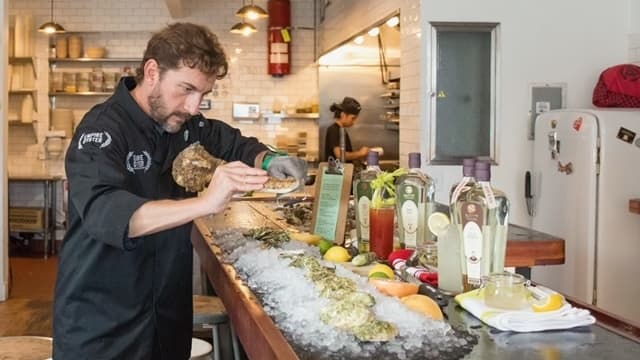This post was originally published on this site
For centuries, the town of Wellfleet, Mass., situated close to 20 miles to the tip of Cape Cod, has built its reputation around the oysters that thrive in its waters. So much so that the briny bivalves are simply known as Wellfleets to many a fan.
These days, those fans are also seeking out oysters from other parts of North America, be they the Island Creek variety from Duxbury, Mass., or the Kusshi from Canada’s British Columbia province. The fervor for oysters reaches a peak of sorts every Aug. 5, which is National Oyster Day.
The broadening interest has left Wellfleet’s oyster industry, a business that has been worth as much as $6.2 million annually to a town with about 3,000 annual residents, challenged to make its mark. In other words, how can the Wellfleet variety, which has been beloved over the years by everyone from Queen Victoria to Anthony Bourdain, become the “it” oyster again?
“You got to work a little harder,” says Jim O’Connell, a veteran Wellfleet oyster farmer, who often rises at the crack of dawn to tend to his harbor plot.
The pandemic has hit the local industry hard, with sales nosediving by about 50% in 2020 to $3 million. There is hope that with the economic recovery and restaurants reopening — notwithstanding issues arising from the delta variant — business will rebound in the short term. But ultimately, the long-term challenge of facing the competition from other oyster-producing locales is the biggest concern.
“
The pandemic has hit the local industry hard, with sales nosediving by about 50% in 2020 to $3 million.
”
The Wellfleet Shellfish Promotion and Tasting (SPAT) organization, a nonprofit group that’s behind the local industry, is the one that’s been doing most of the heavy lifting. As part of its recent efforts, it has been working with a brand-development consultant and has trademarked the phrase, “Wellfeets. The Quintessential American Oyster,” as a way to stand out from the crowd.
The Wellfleet SPAT has also spotlighted an educational video, produced by famed chef Ming Tsai, about how to shuck an oyster (naturally, a Wellfleet oyster). Key to his tips: Using a true oyster knife for the task. “Don’t try with a screwdriver,” he warns.
Finally, the SPAT has hosted an annual festival, called OysterFest, although the 2020 and 2021 editions were cancelled because of concerns about COVID-19.
Locals point to the fact that restaurant raw-bar menus have gotten increasingly larger over the years, and that the order of a dozen Wellfleets is now becoming a platter filled with other varieties.
“Even though people still know Wellfleet, you don’t want to lose your place on that platter,” says Wellfleet shellfish constable Nancy Civetta, who is charged with making sure both commercial people and those who purchase a recreational permit obey the local regulations.

‘The problem is everyone has had 7,000 Wellfleets. They want new stuff,’ says shellfish expert Kevin Joseph.
Margaret Pattillo
Wellfleet still could face an uphill climb, says Kevin Joseph, a New York-based caterer who specializes in oysters and other shellfish. He says the Cape Cod variety may ring as a bit too tried-and-true for oyster lovers.
“The problem is everyone has had 7,000 Wellfleets. They want new stuff,” he says.
Those in Wellfleet counter that their oyster can hold its own by virtue of its briny yet buttery taste and its solid texture. Mac Hay, who owns a chain of seafood restaurants throughout Cape Cod, also notes that it’s a very easy oyster to shuck.
“It has a nice hinge to it,” says Hay. (His idea for promoting the local bivalve? Hosting a Wellfleet OysterFest in Las Vegas.)
At least some oyster lovers and restaurateurs are continuing to place their faith in the Wellfleet. Suzanne Riva, owner of Follia, a New York City dining spot, says that while she rotates among different oyster varieties for her menu, she always finds herself returning to the Cape Cod classic.
“It doesn’t need anything but a squeeze of lemon, if that,” she says.

